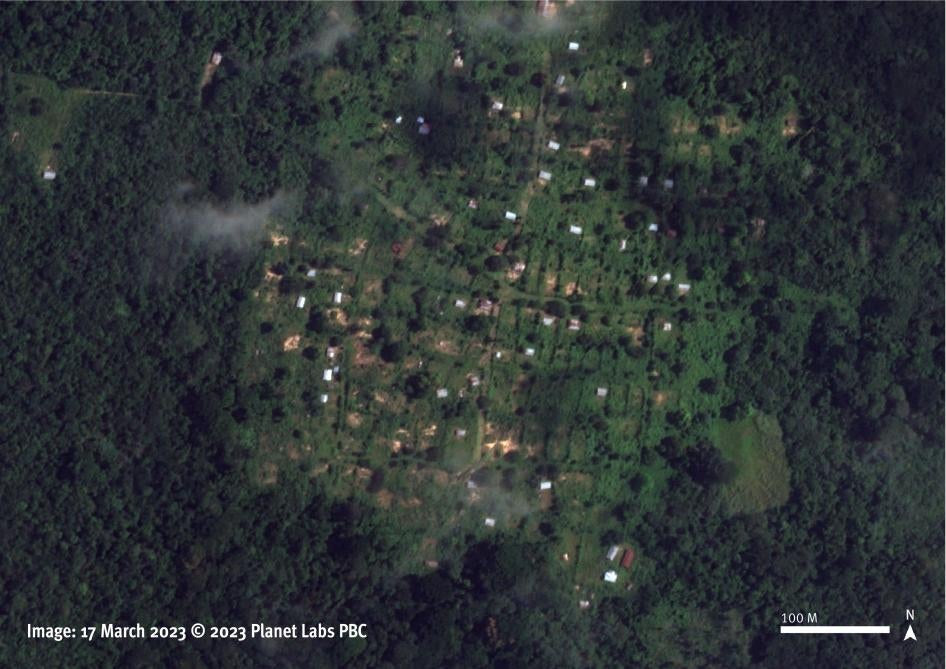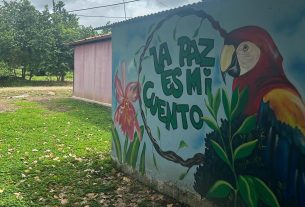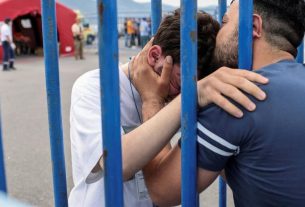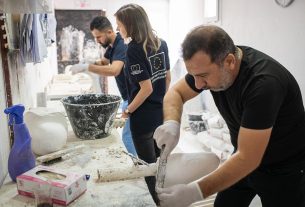(Kinshasa) – Intercommunal violence in the Democratic Republic of Congo’s western Kwamouth territory from June 2022 to March 2023 has killed at least 300 people in cycles of attacks and reprisals, Human Rights Watch said today. The government should urgently address longstanding disputes over customary power and land rights to prevent recurring violence.
Villagers from the predominantly Teke and Yaka communities involved in a dispute over a customary tax and access to land damaged, destroyed, pillaged, and burned hundreds of houses, as well as schools and health centers. Some Congolese security forces deployed to quell the violence allegedly committed extrajudicial executions, looting, and sexual violence. The government did not reinforce overwhelmed provincial security forces until September and failed to provide adequate assistance to the more than 50,000 people displaced by the violence. The authorities should fully and impartially investigate the killings, bring those responsible to justice, and facilitate access to humanitarian aid for those in need.
“The Congolese authorities should urgently take necessary measures to protect civilians in the west from further attacks and uphold the rule of law,” said Thomas Fessy, senior Congo researcher at Human Rights Watch. “It’s critically important to bring those responsible for the deadly violence in Kwamouth to justice and to address the underlying grievances.”
Human Rights Watch’s findings are based on research trips to the town of Bandundu in November, to Maluku in December, and in-person and phone interviews in Kinshasa. Human Rights Watch interviewed 70 people, including 31 survivors and witnesses to the attacks, as well as victims’ family members, judicial officers, lawyers, aid workers, civil society activists, church leaders, members of parliament, security force personnel, United Nations staff, and provincial and national officials.
Teke people have historically owned much of the land and customary titles in Kwamouth territory, in the western province of Mai-Ndombe, as part of the Bateke Plateau (literally “the Plateau of Teke people”), which extends to the outskirts of Kinshasa, the capital, to the south. Over the years, members of the Yaka, Mbala, Suku, and other communities from neighboring Kwilu and Kwango provinces have formed an agricultural workforce for landowners in Kwamouth territory or have become farmers in return for a customary tax – which Teke farmers also pay – in the form of goods collected by Teke customary chiefs.
Tensions simmered over the customary tax throughout 2021 and reached a boiling point in February 2022, when Teke chiefs announced a tax increase, which many farmers rejected. Human Rights Watch received credible information that Teke chiefs subsequently attempted to forcibly collect the tax. On June 9, a group of mainly Yaka and Mbala farmers amassed at a Teke chief’s house in the village of Masia Mbe in protest, reportedly throwing rocks at the building. The chief’s brother opened fire with a hunting rifle, killing one of the farmers. The next day, scores of mainly Yaka villagers stormed Masia Mbe, burning down houses and looting the village.
A series of deadly attacks and reprisals ensued in the following days, forcing several thousand people to flee their homes. Starting in late June, Yaka community members organized in groups, calling themselves “Mobondo” after mystical amulets. Armed with machetes, knives, spears, bows and arrows, hunting rifles, and some military assault rifles, they attacked and killed dozens of Teke villagers, witnesses said. They raided villages and burned down houses. The Catholic Church reported in October that the attackers had stopped protesting customary taxes but sought to “take over the Bateke plateau’s land.” By September, the violence had spread to the neighboring province of Kwilu, and by October it had reached the outskirts of Kinshasa.
Some Teke villagers joined the initial burst of violence, targeting the Yaka as well as their shops and houses. But Mobondo assailants soon overran them. Several survivors and witnesses said the attackers would round up villagers and ask them to state their ethnic group, targeting the Teke and those perceived as having ties with them.
A 30-year-old woman who survived an attack on the village of Fadiaka in September said that many of the assailants had painted their faces black with red strings attached around the head. She said that they first went to the [Teke] chief’s house and shot him dead. “[An assailant known as] Américain then cut his head off. They burned his body attached to a tire, and then left with his head.”
The Congolese security forces eventually made arrests. The military court has been trying at least 115 people on charges related to acts of terrorism, murder, arson, criminal conspiracy, illegal possession of military equipment, and looting. At time of writing, nearly 300 more people were in detention and under investigation in connection with the violence, according to judicial sources.
Four Congolese security force members were sentenced to death for the extrajudicial killings of captured assailants, and eight others were sentenced to up to 20 years in prison for abuses in response to the Kwamouth violence. Another 41 soldiers and police personnel were detained and are under investigation.
On November 15, Congo’s national police issued a wanted notice for insurrection for six men suspected to be among the main planners of the violence. However, the government has since appointed some of them to mediate between the communities. Since December, hundreds of Mobondo who surrendered have been transferred to army enrollment and training centers, without being properly vetted for possible involvement in abuses.
Human Rights Watch previously documented the 2018 Yumbi intercommunal massacres, also in Mai-Ndombe province and over customary power, during which at least 535 people were killed. Little progress has been made in a trial that started in 2021. The killings in and around Kwamouth highlight the impunity for serious crimes that continues to fuel violence in Congo’s western region.
The Office of the United Nations High Commissioner for Human Rights should investigate the killings and other alleged abuses, and assist the Congolese government with technical support, including forensic assistance. The military prosecutor should transfer appropriate cases to the civilian courts, in line with the UN Human Rights Committee guidance that civilians should be tried by military courts only under exceptional circumstances and only under conditions that genuinely afford full due process.
The Congolese government should develop a long-term strategy to enhance security in and around Kwamouth territory. The government, with international assistance, should provide necessary humanitarian assistance and health care – including psychosocial support – to people in need. The government should seek foreign assistance to repair and rebuild homes and reconstruct schools and health centers, with a view to facilitating the safe and voluntary return of those displaced.
“The Congolese government response to the months long Kwamouth crisis has been wholly inadequate,” Fessy said. “The failure to provide meaningful and durable solutions over customary taxes and land tenure, as well as accountability for past atrocities, leaves communities exposed to more deadly cycles of violence and retaliation.”
For additional details and accounts, please see below.
Violence Over Customary Land Rights
Kwamouth is one of eight administrative territories in Mai-Ndombe province in western Democratic Republic of Congo. Flanked by the Congo River as a shared border with the Republic of Congo, Kwamouth territory reaches the outskirts of Kinshasa to the south.
While Mai-Ndombe has been largely peaceful in recent decades, longstanding grievances between the various ethnic groups in the area have occasionally triggered violent confrontations over access to land, customary leadership, and administrative demarcations that date to colonial times. Prior to the 2022-2023 violence, the most recent bloodshed from such rivalries was the 2018 violence in Yumbi, further north along the river.
Conflicts over land and customary claims have erupted between so-called “native” and “non-native” communities. Following escalating tensions throughout 2021 between community leaders over the customary royalties that “native” Teke chiefs demand from farmers, the dispute turned violent in June 2022.
Multiple sources told Human Rights Watch that shortly after Teke chiefs announced the land tax increase on farmers, a fake letter attributed to the Congolese Interior Ministry’s chief of staff and allegedly circulated by agents of the local office of the National Intelligence Agency (Agence nationale de renseignements, ANR) suspended the tax hike. Farmers from the mainly Yaka community invoked the letter in refusing the increase.
Violence broke out on June 9 when farmers took the dispute to the home of a Teke chief in Masia Mbe. One of the farmers was killed and the next day people from the community started raiding Teke villages, said various officials, church leaders, and displaced residents.
Killings, Looting, and Other Abuses
The number of villages that have been attacked since the violence began is difficult to determine. At least 43 largely Teke villages in Mai-Ndombe, Kwilu, and Kinshasa provinces were raided between June 2022 and early March 2023. At first, some Teke villagers tried to defend their communities, or targeted houses and shops belonging to Yaka or other non-Teke ethnicities, killing some people. However, the Teke were soon either outnumbered or unable to repel the groups of dozens of assailants possessing firearms and crude weapons. These assailant groups – mainly from the Yaka community but also Suku and others – formed a movement calling itself “Mobondo” in reference to the protective amulets they wore.
Villagers and officials said the groups often warned residents in writing of an upcoming assault, prompting many villagers to flee beforehand. The assailants would then loot, destroy, and burn houses and infrastructure, and target those who stayed behind. They erected roadblocks on the main roads.
Several witnesses from various villages said the assailants would first attack the customary chiefs, hoping that killing them would prevent resistance. A 19-year-old Teke, displaced to Bandundu following an attack on his village, Bisiala, on September 20, said he saw assailants entering the village looking for the chief. However, “when they realized he was gone, they started killing people on their way and burning houses … We didn’t fight them because they were more powerful than us.”
A priest said he went to Bisiala two days after the attack to bury his cousin and his daughter, who were both killed in front of their house. He said he personally counted 53 bodies and helped bury 7 children – 4 boys and 3 girls – in the same grave as his relatives. “Soldiers who had come from Kinshasa found volunteers to bury the bodies,” he said. “I gave prayers for the dead.” Human Rights Watch was not able to independently corroborate the death toll, but four other displaced people from Bisiala said that scores of people were killed during the raid.
A 27-year-old Teke man displaced in Maluku with his two children said that one day in August people in his village of Bokete found a piece of paper that read “leave or tonight we will come to kill you.” Hours later, his wife, an ethnic Mbala, was found dead by the river, her throat slit. “I know they killed her because of me, because she was married to a Teke,” the man said. “We can’t understand what’s happened, we were all living together, we married each other, Teke and Yaka.”
A 49-year-old trader, who is Yansi – an ethnic group perceived as having ties with the Teke – said a group of Yaka assailants ambushed his truck on the road to Bandundu on September 3:
They asked us to get out of the truck and introduce ourselves in our mother tongue to prove our tribe [of origin]. When I said that I was a Yansi, they said “we are looking for you the Yansi because you are allied to the Teke.” They said they needed to spill my blood … One of them struck my leg with his machete. They ordered us to lie on the ground to execute us, I was petrified thinking I was about to die. I told them I wanted to pay for my blood with the 300,000 Congolese francs (US$150) I had with me. They told me to get up to give them the money. That’s why they spared me and the truck driver. Back on the road, we saw three bodies.
Other survivors and witnesses gave similar accounts of being asked to not only confirm their ethnic group but also prove it by speaking the relevant language.
A member of the Yansi community said he escaped a group of assailants who raided the village of Liduma on September 2. His house was burned down, and he hid in the bush for three weeks. “[A group of] Yaka found me and accused me of making weapons for the people of Liduma because I am a blacksmith, but others defended me and I was spared,” he said. “They had arrows and hunting rifles. They would force people to join them and initiate them to amulets. Those who refused would be killed.”
A senior judicial officer said at least 288 bodies had been recovered and buried so far, but warned the death toll was most likely higher given that some areas had yet to be reached. The United Nations Joint Human Rights Office in Kinshasa said in February it had “received credible allegations” that 322 people had been killed, including 53 victims of extrajudicial executions by government security forces.
Displacement and Inadequate Assistance
Provincial authorities reported that more than 50,000 people were estimated to be internally displaced by the violence as of late December, and another 20,000 had already returned home. Most have fled within Mai-Ndombe and Kwilu provinces, or to the neighboring provinces of Kwango and Kinshasa. About 2,600 refugees had crossed the border to Congo-Brazzaville as of late October, according to the UN refugee agency.
“The [displacement] figures are probably underestimated because it’s difficult to know exactly how many are displaced,” a UN source said.
Many families were separated while fleeing the violence, and some lost their lives. Some reportedly drowned in the river. A 65-year-old man displaced in Maluku, near Kinshasa, said he lost sight of his wife and eight children while trying to reach a barge on the Congo River. “It was like a battle to get to it, and we lost sight of each other,” he said. “I thought they’d made it to the barge, but I never saw them again.”
“The humanitarian consequences have been intentionally downplayed [by the government], and there’s been very little humanitarian assistance,” an aid worker said. The UN source said aid agencies were overstretched with operations in eastern Congo and “it took time to mobilize and get the distributions started – aid really started rolling in November.” Congolese authorities say they provided food, medicine, fabric, mattresses, buckets, and kitchen utensils to the displaced.
Several displaced people, aid workers, and a provincial official said that in October the government gave 200,000 Congolese francs (US$100) to each household in Malebo camp – which at the time hosted nearly 2,500 people – and urged them to return home, in an attempt to close the camp despite insecurity in the places they had fled. “This was a masked eviction … such treatment really is inhumane,” the provincial official said. “Some left but [several hundred] stayed around, not knowing where to go … [T]hey ended up forcing their way back in [the camp] a few days later.” An aid worker emphasized the ongoing security risks in displaced people’s home areas: “There’s been so much destruction and houses burned; what signs will the displaced consider as positive for returning home?”
When Human Rights Watch visited the town of Bandundu in November, displaced people were staying with host families or at the Malebo market, which had been turned into the camp that the government attempted to close in October. There, the displaced were sleeping on the floor of warehouses and complained they were receiving no assistance. “We haven’t received any food or rations, no solution has been found for us, we are suffering,” said a 49-year-old father of seven, who reached Malebo camp in October. “Our children are getting sick because of the mosquitoes – just see how we sleep here. Where is the government?”
Aid workers also warned about “invisible wounds” such as trauma. A Médecins Sans Frontières psychologist, Joel-Christopher Bolombo, who has been providing mental health care to displaced people in Kwamouth, said, “some patients have nightmares, develop a mistrust of other communities that they did not have before, or show signs of depression or feelings of guilt.”
Attacks in March prompted new displacements.
Under the African Union Kampala Convention on internally displaced persons in Africa, which Congo has ratified, governments are obligated to consult with and ensure the participation of internally displaced people in planning and managing their return, resettlement, or integration. They should never face “forcible return to or resettlement in any place where their life, safety, liberty and/or health would be at risk.” In accordance with the convention, the Congolese government should also provide displaced people with “food, water, shelter, medical care and other health services, sanitation, education, and any other necessary social services.”
The authorities should provide displaced people and other survivors with assistance to rebuild their lives, including medical care and psychological and social support, Human Rights Watch said.
Abuses by Congolese Security Forces
The two dozen or so Congolese soldiers assigned to Mai-Ndombe province were the first deployed in response to the violence but were soon unable to cope with the scale of the attacks. As the Congolese government sent reinforcements in September, some security force members allegedly committed abuses in areas of operations.
A senior judicial source said that at least 53 security force members were either under investigation, being prosecuted, or already had been sentenced for crimes committed during the operations, including summary executions of captured assailants, looting, arson, and sexual violence.
The total number of detainees that the Congolese military and police summarily executed is not known. A military source said that an army captain had allegedly killed at least 12 detainees somewhere between Mbomo and Salongo in October. “He was taking them to the army headquarters in Masia-Mbio,” the source said. “They had killed soldiers in Engwene, so … he shot them all dead with his weapon.” A displaced man in Kinshasa said that “assailants had looted [the village of] Engwene, where they also killed soldiers … [S]oldiers were then very angry, not trusting any community, and killed many people.”
On February 6, Patrick Muyaya, the Congolese minister of communication and the government spokesman, told reporters in Kinshasa that “some soldiers [had] behaved badly on the ground and were already being investigated.”
One soldier was sentenced to 20 years in prison for raping a captured female assailant, the senior judicial source said. Four others were sentenced to death for extrajudicial executions of prisoners. Human Rights Watch opposes the death penalty in all circumstances because of its inherent cruelty; those sentenced to death will serve life sentences given Congo’s moratorium on the death penalty.
Alleged Planners of the Violence and Government Response
The Congolese government sent its first delegation to Kwamouth territory only in late August, two months after the first deadly attacks and after many months of simmering tensions in the province following intercommunal violence in 2018. “Kinshasa reacted too late, if I can put it like that,” a Kwamouth territory official said, noting that military reinforcements were only sent in September.
The scale of the attacks as well as the modus operandi of the Mobondo groups demonstrated some degree of planning, and included the organized participation of hundreds of people, mainly recruited among the Yaka, Suku, Mbala, Ndinga, and Songo communities. The use of military assault rifles suggests weapons have been channeled to the assailant groups. Multiple sources said some of the area’s most prominent farmers led assailant groups, allegedly holding meetings at their farms to plan attacks. These men are only known by their nicknames: Sadam, Cobra, Américain, Kapenda, Ephraïm, and Wamba.
Self-proclaimed customary chiefs also allegedly played a role in the attacks. Judicial, police and military sources, church and civil society leaders, and provincial members of parliament all named Odon Nkimona Kumbu, known as “Kiamvu,” a royal Yaka title he reportedly gave himself, as one of the main planners and instigators of the violence.
On November 15, the national police issued a wanted notice for Kiamvu, Kapenda, Sadam, Cobra, Ephraim, and Américain. Described as the intercommunal violence’s “intellectual authors,” they are all being sought for the crime of insurrection. None are known to have been arrested. Instead, some of them, including Kiamvu, were officially tasked with mediating between the communities in conflict and helping to demobilize assailants as part of a “pacification commission” set up by the president in September and led by Mini Kongo, a former wrestler and self-proclaimed Suku customary chief who is perceived to be allied to Yaka farmers.
“I can confirm that they [those wanted by the authorities] are part of the commission so they can convince their members to come out of the bush,” Interior Vice-Minister Jean-Claude Molipe told Human Rights Watch on March 2. “It’s our strategy to avoid a bloodbath, and when the [peace and reconciliation] phases are completed, they will face justice.”
As part of the commission’s work, about 1,200 members of Mobondo groups surrendered and were handed over to the Congolese army, which transferred them to military training centers. In a video circulated in early January, a senior army officer addresses a group of newly surrendered Mobondo members in front of Mini Kongo. He says to them: “Tell those who are still in the bush to come out. The vehicles to take you out are available. To go where? To Kinshasa for training and then in the east to fight [the Rwandans] and liberate our Congo!”
The surrendered men then chanted “Mobondo! Sadam! Mobondo! Sadam!” in reference to one of their leaders.
On January 29, Molipe, Mini Kongo, and Nana Manwanina Kiumba, a government minister in the Office of the President, oversaw the departure at Kinshasa airport of dozens of surrendered assailants to military training centers. It is unclear how many Mobondo members remain at large, but a new spate of attacks in early March suggests they still have capacity to cause harm.
Congolese authorities should enforce the wanted notice, investigate all allegations of serious offenses, and bring to justice those responsible for the deadly violence, Human Rights Watch said. Former members of Mobondo groups should be fully vetted to ensure that new army recruits have not been involved in serious human rights abuses. Those suspected of involvement in abuses should be impartially investigated. Those found responsible should be prevented from joining the army and appropriately prosecuted.




